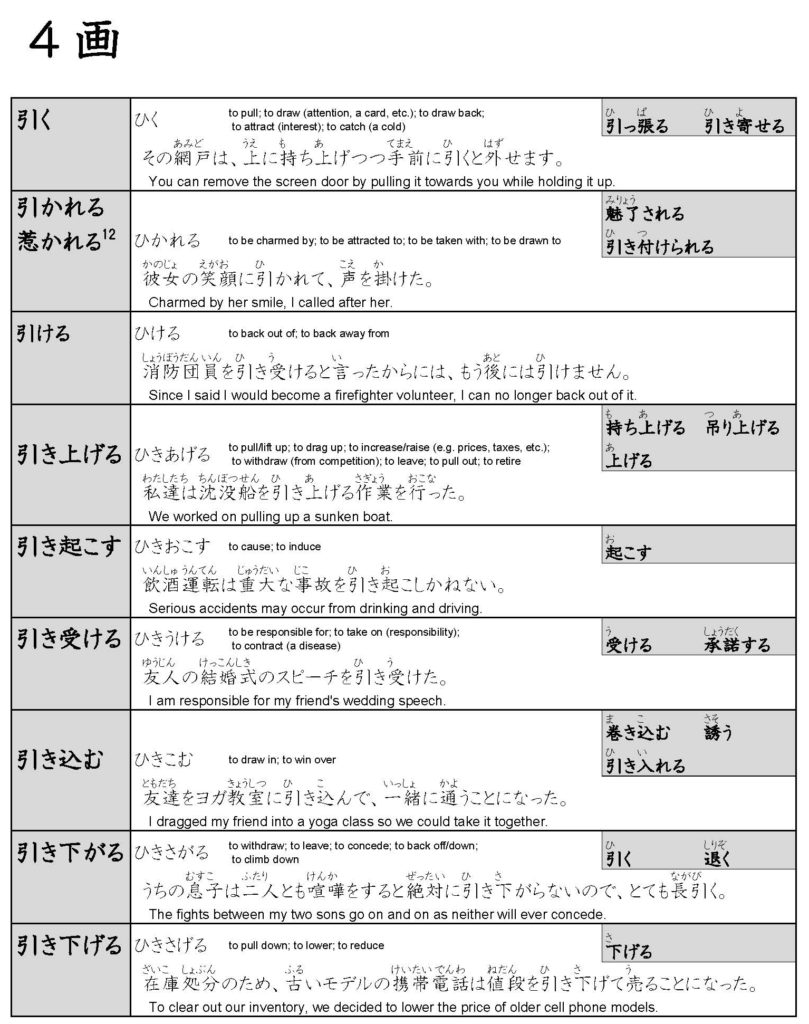The Handbook of Japanese Verbs
Expand your vocabulary and linguistic ability in Japanese."An invaluable resource for people who want to speak Japanese. You'll appreciate all the resources packed in it." - Claire Vatsika![]()
![]()
![]()
![]()
![]()
![]()

The Handbook of Japanese Verbs
Expand your vocabulary and linguistic ability in Japanese."An invaluable resource for people who want to speak Japanese. You'll appreciate all the resources packed in it." - Claire Vatsika
![]()
![]()
![]()
![]()
![]()
![]()
![]()
A guide designed to master the most essential verbs of the Japanese language. Containing over 2,800 verbs, this comprehensive reference book equips learners with the knowledge necessary to live and work in Japanese society.
効率的な時間短縮で、
語学力向上へ
Reduce time studying while improving linguistic ability effectively
Pages
Verbs
Synonyms
Example sentences
The Secure Path To Knowledge.
The Learning Process
The speed in which one acquires another language is determined by the quality of resources available and their own intrinsic motivation. However, even the most motivated need guidance―tools for success that help them expedite the learning process on the road to proficient linguistic ability.
Ease of learning is comprised of three essential components:
- Coherent Organization of Pertinent Information
- Study Methodology
- Comprehensive Review and Overview of Study Material
These three components serve one main purpose―memory retention. Consistent exposure to relevant material helps the learner to visually and verbally recall the study material. Once the information becomes familiar, the ability to recall vocabulary will improve, thereby increasing one’s linguistic fluency.

Learn. Review. Recall. Apply!

How to Use This Book
The intent of this book is to expand one’s knowledge base as fast as possible by using a methodical approach to acquire new vocabulary and to improve one’s ability to recall synonyms of the target vocabulary effortlessly. The user will learn how to recognize, read and use over 1000 kanji (traditional Chinese characters) by first building familiarity with the concept of those kanji. Once able to use the target verbs in conversation, the learner should make use of the synonym section to add variation to their linguistic skill set.
This handbook is composed of five main sections which aid memory retention:
- Verb Overview (to test one’s ability to recall vocabulary with minimal visual cues)
- Verb Summary (to test one’s ability to read vocabulary and recall definitions)
- Verb Details (to learn by succinct definition, example, and related vocabulary)
- Japanese-English Dictionary (to quickly look up by words by sound)
- English-Japanese Dictionary (to find accurate translations of English vocabulary)
Let’s start by explaining our recommended study methodology. There are four steps to obtain fluency:
Learn. Review. Recall. Apply.
It is important to note that you do not need to learn from this book in numerical order. One could start learning immediately from at any section of this book, but we have found that the learner’s time is best spent by first testing their ability using our verb summary pages and allowing this to guide their focus. Follow the steps listed below to start learning new vocabulary today.
A Brief Description of The Steps To Learn New Vocabulary
Step 1: The Test
Test yourself by starting from the top of the vocabulary list in the summary section and work your way down. Read the first word, “引く” and ask yourself how to pronounce it: ひく (Hiku). Do you know the English equivalents?
to pull; to draw (e.g. attention, a card, etc.); to draw back;
to attract; to catch (a cold)
Can you think of any synonyms for this word? 引っ張る and 引き寄せる
If you feel confident that you already know this word, move down to the next and test yourself again. If you can read it, but are not 100% confident in your ability to use it, nor are able to recall any synonyms, we recommend drawing a ”△” next to it. If you cannot read it and are not familiar with its usage, write an ”X” next to it. As you continue to learn and review the target vocabulary, update the symbols next to them.
Your goal is to remove all of the symbols next to the target vocabulary.

Step 2: Learn Target Vocabulary
Now that you know which verbs you are not familiar with, it is time to start increasing your knowledge base. Turn to the next page to look at the specific information for each verb:

A. Target Verb – Your goal is to be able to use this word on command
B. Hiragana Reading – This is the reading of the target verb
C. English Definition – The English equivalent to the target verb.
D. Example Sentence – Japanese sentences are provided with English translations to expand your vocabulary
E. Synonyms – Synonyms to the target verb are included for reference when applicable
Once you feel comfortable with this verb, move on to the next and repeat the process. Try learning a few verbs each day and make sure to review in the evening. Constant exposure is vital to memory retention! Here are some examples of pages found in The Handbook of Japanese Verbs:

Step 3: Review by Using Summary Sheets
Repeat Step 1 for all of the verbs you have learned each day. Try working your way through the entire list and update the symbols when you feel confident in your ability to recall the pronunciation, definitions, and synonyms.
Step 4: Recall by Using Reference Kanji
While this step is not essential to the learning process, we believe it does help build familiarity with the kanji and its related verbs. Use the top of the summary page to glance at the main Japanese and Chinese readings. Knowing which verbs you can create from simply thinking of a kanji will help your brain link concepts with possible actions.
Look at the kanji, “引” and ask yourself what is the main action associated with this character. 引 typically depicts the action to pull. 引き上げる; 引き摺る; 引き伸ばす; 引っ越す subsequently mean to lift up; to drag; to stretch; to move homes. Increasing your recall speed will improve your ability to speak extemporaneously.
Step 5: Apply Your Knowledge
Simply put―use your knowledge. Make sentences using the target vocabulary. Whether you say sentences in your head, out loud or you choose to write them down, output is the last essential step to mastering another language. Start by making simple sentences with the target vocabulary. Once you feel comfortable doing so, try including an adverb into your sentences to make them more vivid and specific. The listener will appreciate this elaboration and subsequently, your sentences will create a lasting impact. Strive to achieve this.
Fluency is neither gift nor talent. It is the result of knowledge, familiarity, and application. With dedication and this reference book as your guide, you will find yourself learning practical Japanese much faster than ever before.
We wish you the best on your journey into the Japanese language. Remember―Learn. Review. Recall. Apply!

Gain confidence and improve your Japanese ability today.
